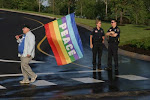The Day I Moved from Conscientious Objector to War Resister by Steve Clemens 9/15/22
I’m not sure which Nixon speech it was. It happened near the end of 1971 or early in 1972. Once again, the President called for an escalation of the war on Vietnam. That day I had received in the mail a letter from the Selective Service Administration (my draft board) asking me, I assume, to update my mailing address since I had just graduated early from Wheaton College and my II-S Student deferment had just expired. I looked at the letter, remembered Nixon’s speech and took it into the bathroom of my parents’ home.
Three years earlier, when I turned 18 in the fall of 1968, I chose to register as a Conscientious Objector. Looking back on that time, it wasn’t a political statement against the War on Vietnam; rather, it was a religious statement that my commitment to the words of Jesus to “love my enemies” took precedence over the demands of my government. For almost a year after filing my claim as a CO, I took no part in anti-war demonstrations in my college town just outside of Chicago. However, in the Spring of 1969 I was invited to attend a “Black Power Symposium” at Augustana College in Rock Island, IL and my carefully constructed conservative white world was turned upside down. That weekend was followed by a week of (compulsory) chapel services at Wheaton led by a former NY street gang member who “got saved, turned his life over to Jesus” and became one of a minuscule few Black, evangelical evangelists, Tom Skinner (https://www.skinnerleaders.org/our-history). Tom recommended that I spend my summer break working in the inner city (aka the Black community) of Philadelphia, just 30 miles south of my childhood home.
That summer introduced me to how the predominately white Philadelphia Police Force (under the direction of a very racist Frank Rizzo) responded to both Black and Hispanic neighborhoods. It was a wake-up call which forced me to consider the intersections between my religious identity and my political and social views. When I returned to my Illinois campus that fall, I joined a local Maryknoll priest in his weekly demonstrations outside the DuPage County Draft Board office in Wheaton. I started attending the weekly Operation Breadbasket services led by Jesse Jackson in Chicago. I chose an African American roommate. And I started reading Ramparts and other “leftist” magazines which were stridently against the war. I helped lead a campus anti-war group named after the pacifist, abolitionist founder of the college, the Jonathan Blanchard Association. I learned about my Anabaptist ancestors in a Bible History course. I met Jim Wallis as he was founding The Post American – which was re-named a few years later, Sojourners Magazine and was reading John Howard Yoder, Daniel Berrigan, and other faith-based peacemaking activists.
I knew there were people in these movements who were “draft resisters” and/or “draft card burners” – but I didn’t know any of them personally. But I also knew the consequences faced by those prosecuted for such: often 2-5 years in prison. So, when I went into my parents’ bathroom after the Nixon speech, I took the Draft Card from my wallet (we were required by law to carry them) and burned it, letting the ashes go down the drain. I knew doing so privately was a bit cowardly, so I then decided to up the risk level. I crossed my name and address off my un-opened Selective Service letter and wrote above it – “Refused, obscene material! - Return to Sender” and put it back in the mailbox.
[Fast-forward 8 years later when President Carter, trying to win re-election against Ronald Reagan, re-instated mandatory draft registration for males between the ages of 18-26. Never mind that I was 30 at the time. I wrote to the President, telling him I refused to resister for reasons of conscience. After numerous threatening letters over the next year, finally two FBI agents showed up at my workplace to inquire about my act of resistance. After politely refusing to tell them my Social Security number, my mother’s maiden name, or my birthplace and age, they decided amongst themselves that I was probably “older than 26” so they said they were closing my case.]
It still took me another 3 years after my burnt draft card for me to embrace “active” nonviolent resistance rather than just reacting to what our government was doing after the fact. Liz McAlister became a friend and mentor along with Phil Berrigan, her husband. She gently pushed me to embrace active nonviolence and see war resistance as a logical outcome if one takes conscientious objection seriously. Then she got arrested with me and 59 others at the White House in the last major demonstration against the Vietnam War in late March 1975. Dan Berrigan, the author who had inspired me and Dick Gregory who challenged me at the Black Power Symposium, were placed in handcuffs alongside me.



